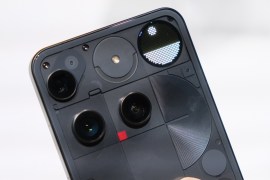Best cheap phones in 2025 reviewed and rated
We rate the best budget phones from Samsung, Nothing, Google and more, all available for under $450/£450
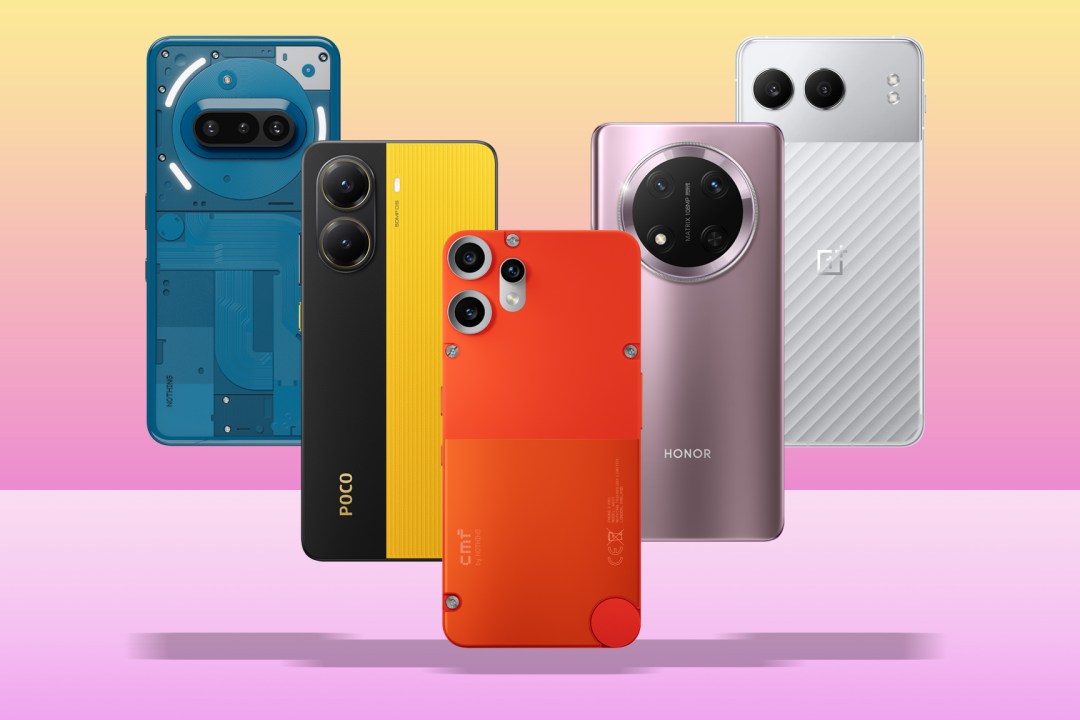
Not interested in spending a princely sum on a flagship phone? Good news: you don’t have to. With solid specs, clever design, and plenty of features, the best affordable phones now offer outstanding value for money.
While you might have to accept a few compromises – think plastic bodies and less impressive secondary cameras – the overall quality of cheap phones has improved significantly in the past few years. Many budget-friendly models now offer excellent displays, strong battery life, and performance that rivals even top-tier devices.
Unsure how to select the best option for your budget? From well-known brands to emerging names, the list below features our top picks of affordable handsets, all priced under $500/£450. Whether you’re searching for a great deal on a primary device or a backup phone that won’t stretch your budget, you’ll find the perfect option in our buying guide.
Why you can trust Stuff: Our team of experts rigorously test each product and provide honest, unbiased reviews to help you make informed decisions. For more details, read how we test and rate products.
Quick list: what is the best cheap phone?
The Nothing Phone 3a (buy now) strips the Nothing experience back in the name of affordability, while keeping everything that made previous efforts so distinctive. Phone 3a is fun, fully featured, and phenomenal value.
The OnePlus Nord 4 (buy now) asserts itself with a metal body and a dazzling screen… and the result is a stunning value-packed phone
The Honor Magic 7 Lite (buy now) has a beefy battery, a capable main camera, and a body that could rival some flagships in the style stakes. It makes a compelling case if affordability is important.
The CMF by Nothing Phone 2 Pro (buy now) is an absurd amount of phone for the cash, with an eye-catching OLED screen, capable pair of 50MP cameras and a MediaTek CPU that can handle 3D games. It’s also got a clever modular accessory system and comes in eye-catching colours.
The Redmi Note 14 Pro+ (buy now) is positively bursting with impressive hardware that you’d be hard-pressed to find in similarly-priced handsets, you get a pixel-packed 200MP main camera, 120W charging and an all-day battery.
The Poco X7 Pro (buy now) embraces modern design, doesn’t skimp on performance or storage, and takes a decent enough photo for the price. It continues Poco’s run of appealing affordable phones.
The Samsung Galaxy A55 (buy now) is a generation old, but there are still plenty in stock at most retailers. It has a sharp, punchy screen and a very capable multi-lens camera system. Inside is the Exynos 14800 CPU and 8/12GB of RAM which make for a far smoother experience than the previous generation A series phones.
The Google Pixel 8a (buy now) has now been superseded, but until the Pixel 9a drops in price, this is the most affordable model in Google’s lineup. Plenty of retailers sell it at a healthy discount from the original RRP.
The best cheap phones you can buy today:
Best cheap phone overall

1. Nothing Phone 3a
Stuff Verdict
By closely sticking to what made its predecessor such a success, the Nothing Phone 3a delivers a superb all-round experience for affordable money.
Pros
- Mid-tier performance and battery for considerably less cash
- Familiar Nothing hallmarks like glyphs and widget-based OS
- Capable cameras for the money, with mature processing
Cons
- Essential space hasn’t proven very essential so far
- Can’t match the 3a Pro for zoom clarity
| Nothing Phone 3a specs | |
| Screen | 6.77in, FHD+ 120Hz AMOLED |
| CPU | Qualcomm Snapdragon 7s Gen 3 |
| Memory | 8/12GB |
| Cameras | 50MP, f/1.88 main, 50MP telephoto, 8MP ultrawide rear 32MP, f/2.2 front |
| Storage | 128/256GB |
| Operating System | Android 15 w/ Nothing OS 3.1 |
| Battery | 5000mAh, 50W wired charging |
| Dimensions | 164x78x8.35mm, 201g 6.46×3.07×0.33 in, 7.09 oz |
The Nothing Phone 3a sticks to the brand’s winning formula, offering a stylish, feature-packed experience at an aggressive price. For $379/£329, you get Nothing’s signature transparent design, glyph LEDs, and a slick, widget-driven OS—plus a new AI-powered Essential Space that aims to declutter your digital life (though it’s not quite essential yet).
Performance is solid thanks to a Snapdragon 7s Gen 3, and the 5000mAh battery keeps up with a full day’s use. The 6.67in OLED screen is vibrant, peaking at a dazzling 3000 nits, while 50W wired charging outpaces some pricier flagships. Camera-wise, the 50MP main and 50MP telephoto (2x optical) deliver detailed, well-balanced shots, though the Pro model’s 3x zoom holds the edge.
Compared to its pricier sibling, the 3a makes fewer compromises than you’d expect. It ditches the Pro’s chunky camera bump while retaining most of its best bits. Sure, zoom clarity could be better, and Essential Space is still a work in progress, but Nothing has delivered one of the most complete budget phones around. If you’re spending under $380/£330, this should be at the top of your list. The Pro may have more zoom, but the 3a is the smarter buy.
- Read more: Nothing Phone 3a review
Best cheap phone for design
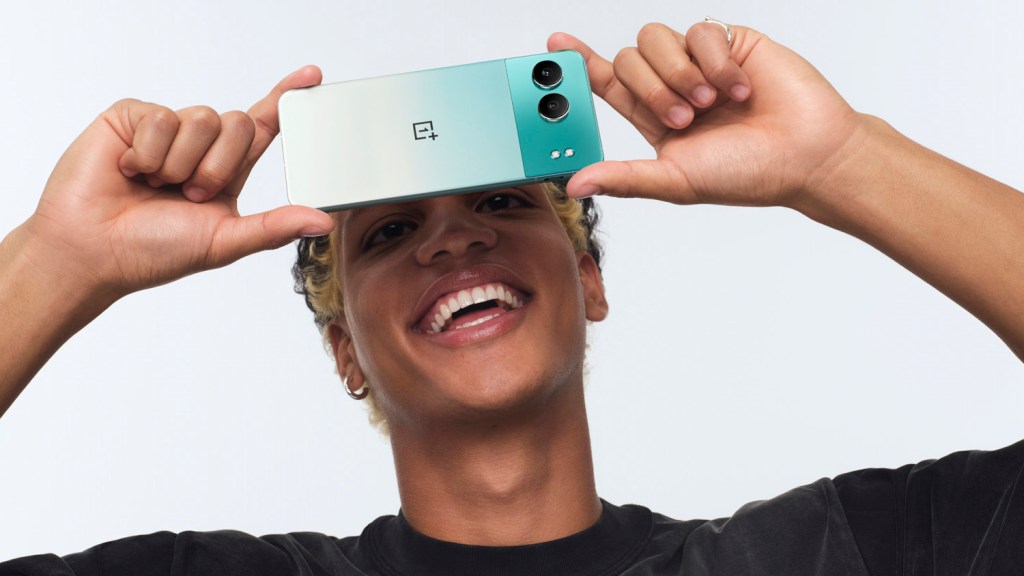
2. OnePlus Nord 4
Stuff Verdict
The OnePlus Nord 4 asserts itself with a metal body and a dazzling screen… and the result is a stunning value-packed phone
Pros
- Four years of full Android updates and six years of security updates
- Sharp 6.74in display, capable of 2000 nits of peak brightness
- Premium luxe design
Cons
- Pre-installed apps
- More storage is expensive
| OnePlus Nord 4 specs | |
| Screen | Screen 6.74in 2772×1240 120Hz AMOLED |
| CPU | Snapdragon 7+ Gen 3 |
| Memory | 16GB |
| Cameras | 50 + 8MP rear, 16MP front |
| Storage | 512GB |
| Operating System | Android 14 + OxygenOS 14 |
| Battery | 5500mAh (USB-C) |
| Dimensions | 163×7 5×8.5mm, 200g 6.42 x 2.95 x 0.33in, 7.05oz |
The OnePlus Nord 4 is a budget marvel that punches above its weight with a premium metal unibody – a rarity in today’s glass-heavy smartphone world. Priced competitively against the likes of Samsung’s A Series and Google’s Pixel 8a, this phone delivers flagship-level style without the flagship price tag.
Its 6.74in AMOLED display, boasting a sharp 2772×1240 resolution and a 120Hz refresh rate, dazzles with up to 2000 nits of brightness and ProXDR support. Aqua Touch tech even makes it easier to use in the rain – handy, given its IP65 water resistance.
Under the hood, the Snapdragon 7+ Gen 3 processor, paired with up to 16GB of RAM and 512GB of storage, ensures smooth performance for everyday tasks and gaming. The 5500mAh battery supports fast USB-C charging, keeping you powered throughout the day.
Photography isn’t its strong suit – the 50MP main camera is solid, but the 8MP ultrawide is basic. However, OxygenOS 14.1 keeps things slick, and OnePlus guarantees 4 years of Android updates with 6 years of security patches.
If you prioritise design and performance over camera prowess, the Nord 4 is an excellent alternative to Google’s Pixel 8a – and one of the best-looking budget phones out there.
Best cheap phone for battery life

3. Honor Magic 7 Lite
Stuff Verdict
This impressively slim phone hides one of the highest capacity batteries in its class. The Honor Magic 7 Lite feels out of step with rivals elsewhere, but makes up for it with a keen price.
Pros
- Simply huge battery for multi-day lifespan
- Bright, sharp AMOLED screen
- Main camera performs well for a value-minded phone
Cons
- Performance is only average
- Phone design trends have moved on from curved-edge displays
| Honor Magic 7 Lite specs | |
|---|---|
| Screen | 6.78in, 2652×1200 AMOLED w/ 120Hz |
| Processor | Qualcomm Snapdragon 6 Gen 1 |
| Memory | 68GB RAM |
| Storage | 256GB on-board |
| Cameras | 108MP, f/1.8 main w/ PDAF + 5MP, f/2.2 ultrawide + 2MP, f/2.4 macro rear 16MP, f/2.5 front |
| Operating system | Android 13 w/ MagicUI |
| Battery | 5300mAh w/ 35W wired charging |
| Dimensions | 164x76x8mm, 185g 6.46×2.99×0.31in, 6.53oz |
The Honor Magic 7 Lite is a budget smartphone that stands out for its colossal 6600mAh battery and rugged build – both rare at this price point. It’s impressively slim at 7.98mm and lightweight at 189g, yet durable enough to survive 2m drops. The AMOLED screen is bright, sharp, and boasts a 120Hz refresh rate, though the curved-edge design feels outdated.
Performance is where things falter. The Snapdragon 6 Gen 1 chip remains unchanged from last year, leading to merely average speeds. The software is also a drawback, launching with Android 14 when rivals already sport Android 15, and Honor’s update commitment lags behind Samsung’s.
The 108MP main camera performs well for its class, especially with the addition of optical image stabilisation for better low-light shots. However, the ultrawide sensor is underwhelming, and zoom relies purely on digital cropping.
Ultimately, this phone is all about endurance. It comfortably lasts two full days, potentially three with light use, making it ideal for festival-goers or frequent travellers. While some might find its performance and design outdated, if you prioritise battery life above all else, the Magic 7 Lite is a solid choice. A shame about the lack of wireless charging, though.
- Read more: Honor Magic 7 Lite review
Best customisable cheap phone

4. CMF by Nothing Phone 2 Pro
Stuff Verdict
An affordable phone sequel with plenty of personality. The CMF Phone 2 Pro makes progress in all the right areas, while keeping the price in check. It’s a fantastic choice if you’re on a modest budget
Pros
- Sleeker design that stays true to original’s modular approach
- Decent budget performance and battery life
- Fixes Phone 1’s flaws by adding NFC, improving IP rating
Cons
- Ultrawide camera is bang average and no OIS limits low-light ability
- Stereo speakers still don’t make the cut
| CMF by Nothing Phone 2 Pro specs | |
|---|---|
| Screen | 6.67in, 2392×1080, 120Hz AMOLED |
| Processor | MediaTek Dimensity 7300-Pro |
| Memory | 8GB RAM |
| Storage | 128/256GB on-board, microSD expansion |
| Cameras | 50MP+50MP+8MP rear, 16MP front |
| Operating system | Android 15 w/ NothingOS 3.2 |
| Battery | 5000mAh w/ 33W wired charging |
| Dimensions | 164x78x7.8mm, 185g |
Not content with having one budget banger in our cheap phones list, Nothing has done the double via its colourful sub-brand CMF. Last year’s CMF Phone 1 shook up the affordable end of the smartphone spectrum, and the sequel goes even better in a few key areas.
The clever interchangeable backs might’ve gone, but CMF has replaced them with customisable cases that let you bolt fun macro and fisheye lenses onto two of its three rear cameras. The modular accessory system remains, though, and the change means water resistance has improved to IP54.
It’s not just gimmicks, though. An AMOLED screen, big 5000mAh battery, and a MediaTek CPU that outperforms rivals in its price bracket make it a brilliant all-rounder for the money. It’s also rocking NothingOS, which, for my money, is one of the best takes on Android 15 doing the rounds right now. No one else does useful widgets and consistent design quite like it. You even get the Nothing Phone 3a’s Essential Space button, which is slowly becoming more and more essential as the firm releases updates.
The triple rear camera setup does a fantastic job for the money, with a 50MP lead lens and 50MP telephoto good for 2x optical zoom. With no optical image stabilisation, it can’t best phones in the $350/£300+ range, but it otherwise copes very well in most lighting conditions. For $279/£219/€249 it’s a serious amount of phone.
- Read more: CMF by Nothing Phone 12 Pro review
Best cheap camera phone
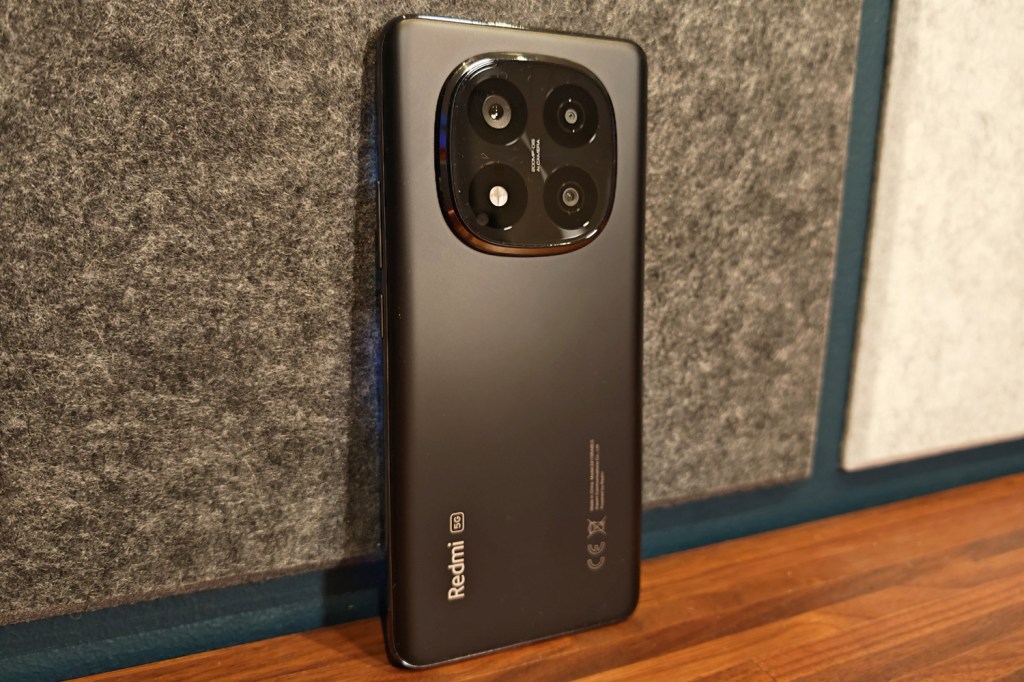
5. Redmi Note 14 Pro+
Stuff Verdict
Fresh looks and new silicon help the Redmi Note 14 Pro+ stay current. It’s not much of a leap from its predecessor in any other area, though.
Pros
- Very detailed shots from the main camea
- Solid mid-range performance
- Respectable battery life and very fast charging
Cons
- Redmi really should’ve called time on the weak secondary cameras
- Dial down the out-of-box bloatware, please
- Why not launch with the latest version of Android?
| Redmi Note 14 Pro+ specs | |
|---|---|
| Screen | 6.67in, 2712×1220 120Hz AMOLED |
| Processor | Qualcomm Snapdragon 7s Gen 3 |
| Memory | 8/12GB RAM |
| Storage | 256/512GB on-board |
| Cameras | 200MP f/1.65 w/ OIS + 8MP f/2.2 ultrawide + 2MP macro rear 20MP front |
| Operating system | Android 14 w/ HyperOS 2 |
| Battery | 5110mAh w/ 120W wired charging |
| Dimensions | 163x75x8.75mmm, 210g 6.42 × 2.95 × 0.34in, 7.4oz |
The Redmi Note 14 Pro+ brings some welcome refinements to Xiaomi’s mid-range lineup, even if it doesn’t reinvent the wheel. The 200MP main camera remains the star, delivering crisp, detailed shots with effective AI-assisted zoom. The OLED display is brighter than before, peaking at 3000 nits for improved outdoor visibility, and the new Snapdragon 7s Gen 3 chip ensures smooth day-to-day performance. Plus, with 120W fast charging, you can go from empty to full in under 25 minutes—faster than many flagships.
Design-wise, Redmi mixes things up again with a central camera module and a choice of glass or vegan leather backs, all wrapped in a sturdy, premium-feeling frame with IP68 water resistance. The software experience is familiar, though we’d have liked less bloatware and the latest Android version at launch. The 8MP ultrawide and 2MP macro cameras feel outdated, but the main sensor makes up for it in most scenarios.
For not very much money, the Redmi Note 14 Pro+ is still a compelling choice, balancing performance, display quality, and camera prowess. While rivals like the OnePlus Nord 4 and Pixel 8a offer stiff competition, Xiaomi’s latest effort keeps pace with the pack—if not quite leaping ahead.
- Read more: Redmi Note 14 Pro+ review
Best cheap phone for performance
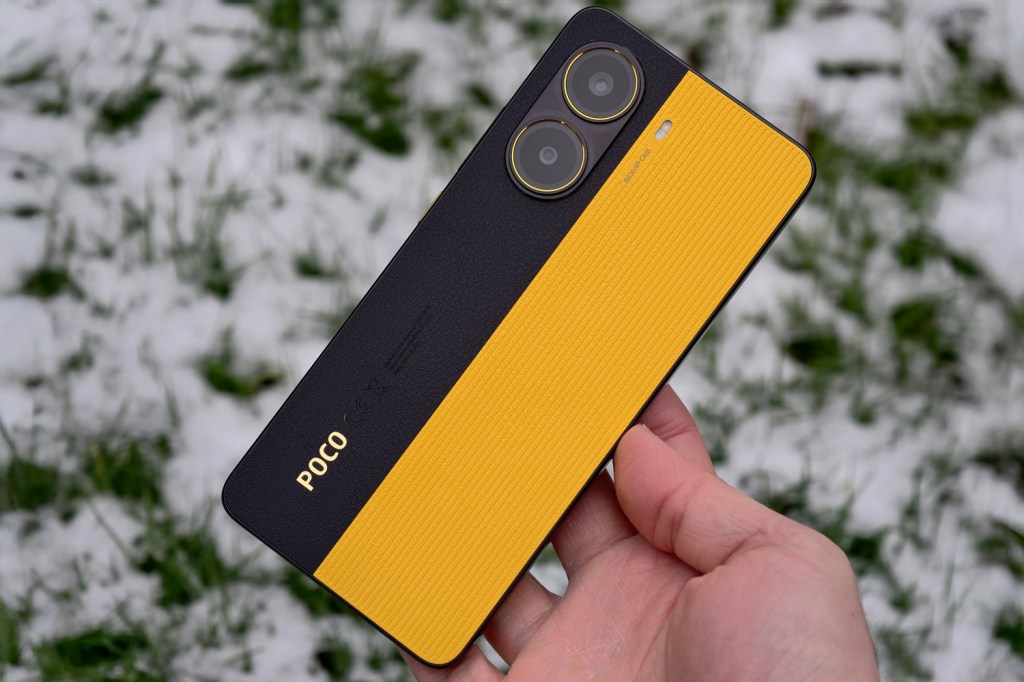
6. Poco X7 Pro
Stuff Verdict
It embraces modern design, doesn’t skimp on performance or storage, and takes a decent enough photo for the price. The X7 Pro continues Poco’s run of appealing affordable phones.
Pros
- Flat screen and sides are so hot right now
- Big battery and very respectable performance
- Lead camera copes well for the money
Cons
- Lots of pre-loaded bloat
- 8MP ultrawide doesn’t cut it
| Poco X7 Pro specs | |
|---|---|
| Screen | 6.67in, 2712×1220 120Hz OLED |
| Processor | Mediatek Dimensity 8400-Ultra |
| Memory | 12GB RAM |
| Storage | 512GB |
| Cameras | 50MP w/ OIS + 8MP ultrawide rear 20MP front |
| Operating system | Android 15 w/ HyperOS 2.0 |
| Battery | 6000mAh w/ 90W wired charging |
| Dimensions | 161x75x8.1mm, 204g 6.34 × 2.95 × 0.32in, 7.2oz |
The Poco X7 Pro delivers impressive value, blending modern design with strong performance at a budget price. We love the flat-sided look, reminiscent of pricier flagships, and the vegan leather back adds a premium touch. The 6.67in OLED screen is bright and smooth at 120Hz, even if colours feel slightly muted out of the box.
Performance is a real highlight. The Dimensity 8400 Ultra chipset punches above its weight, keeping things slick whether gaming or multitasking. Battery life is solid thanks to a 6000mAh cell, and 90W fast charging gets you back to full in no time. The 50MP main camera delivers respectable shots, though the 8MP ultrawide is forgettable.
Software-wise, Xiaomi’s HyperOS is feature-packed but loaded with bloatware. IP68 water resistance is a rare bonus at this price, and stereo speakers hold up well.
Ultimately, the Poco X7 Pro is a strong contender in the budget space. The Nothing Phone 2a has a better camera, but Poco offers more power and battery life. If you can overlook the pre-installed apps, this is a great buy—another reminder that budget phones don’t have to feel cheap.
- Read more: Poco X7 Pro review
Best cheap Samsung phone
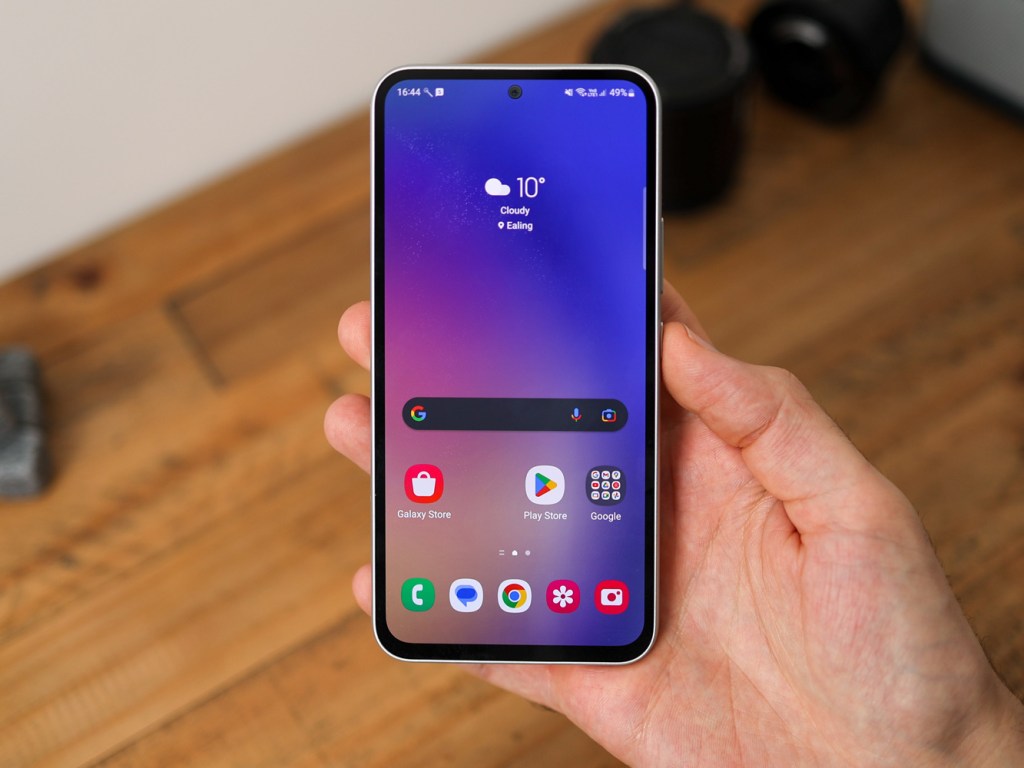
7. Samsung Galaxy A55
Stuff Verdict
The A55 is a great shout for anyone who can’t justify S24 prices but still wants Samsung’s latest smarts
Pros
- Materials and build quality on par with pricier phones
- Decent performance and respectable battery life
- Capable cameras for stills and video
Cons
- Screen bezels are a bit bulky
- Tries to tempt you with bloatware on initial setup
- Similarly fast and long-lasting rivals cost considerably less
| Samsung Galaxy A55 specs | |
|---|---|
| Screen | 6.6in, 2340×1080 AMOLED w/ 120Hz |
| Processor | Samsung Exynos 1480 octa-core |
| Memory | 8/12GB RAM |
| Storage | 128/256GB on-board, microSD expansion |
| Cameras | 50MP, f/1.8 w/ PDAF, OIS + 12MP, f/2.2 ultrawide + 5MP, f/2.4 macro rear 32MP, f2.2 front |
| Operating system | Android 14 w/ OneUI |
| Battery | 5000mAh w/ 25W wired charging |
| Dimensions | 161x77x8.2mm, 213g 6.34×3.03×0.32in, 7.51oz |
Want the Samsung prestige without the high-end price tag? Then the A55 is a budget contender worthy of your shortlist (even though the Samsung A56 has now been released, it’s a bit outside our price range at the moment). With a price tag well below the lofty heights of the Galaxy S24 range, this is a super affordable handset which sacrifices some flagship style and power, while still providing a solid smartphone experience.
One of its standout features during our review was its sharp, punchy screen, along with its capable multi-lens camera system, with a decent selfie camera to boot. And unlike previous A series phones (which massively disappointed on the power front), we’re pleased to report that the A55’s Exynos 1480 CPU and 8/12GB of RAM make for a far smoother experience.
Throw in reasonably fast (though far from groundbreaking) 25W charging, and you’ve got yourself a more affordable Samsung handset that provides the highly coveted Samsung-esque experience, at a far more palatable price.
- Read more: Samsung Galaxy A55 review
Best cheap Google phone
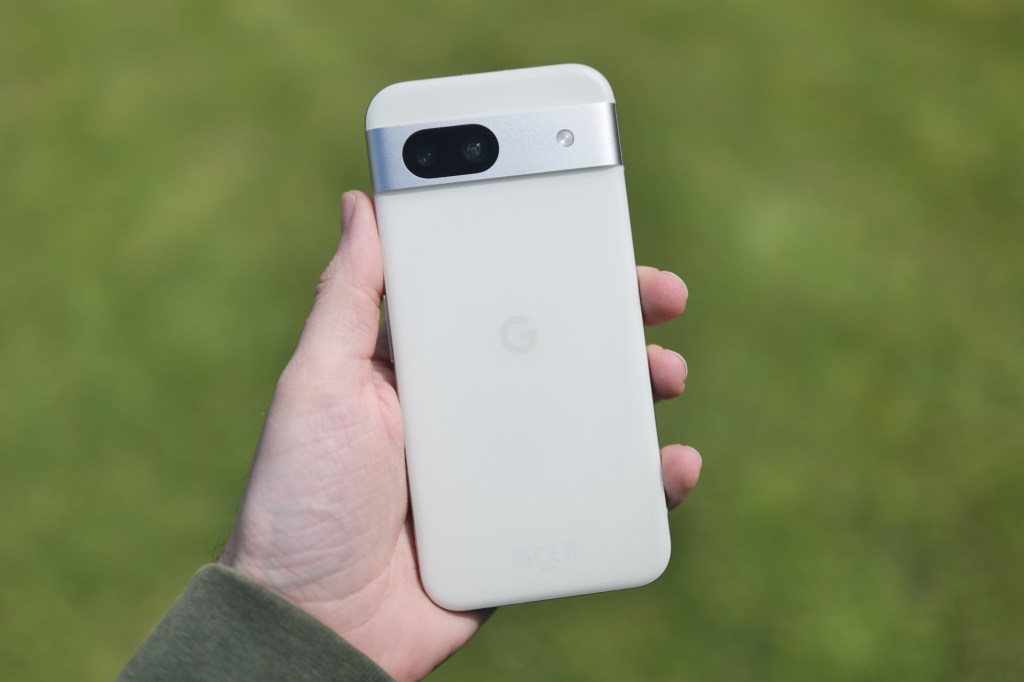
8. Google Pixel 8a
Stuff Verdict
With similar hardware to its more expensive siblings, the Pixel 8a is the cheapest way to access Google’s AI smarts. With amazing photography skills, the Pixel 8a is an excellent budget smartphone
Pros
- Same superb photography skills we expect from Pixel phones
- Performance punches above its price bracket
- Slick design and strong build
Cons
- Gemini AI chatbot not available in UK and Europe
- Charging speeds remain behind rivals
| Google Pixel 8a specs | |
|---|---|
| Screen | 6.1in, 2400×1080 OLED w/ 120Hz |
| CPU | Google Tensor G3 octa-core |
| Memory | 8GB RAM |
| Cameras | 64MP, f/1.9 main w/ OIS + 13MP,f/2.2 ultrawide rear 13MP, f/2.2 front |
| Storage | 128/256GB |
| Operating system | Android 14 |
| Battery | 4,492 mAh w/ 18W wired, 7.5W wireless charging |
| Dimensions | 152.1 x 72.7 x 8.9 mm 6.0 x 2.9 x 0.35 in |
| Weight | 188 g / 6.63 oz |
Even though the Pixel 8a has been replaced by the newer (and more expensive) 9a, the Pixel 8a remains an excellent budget choice while stocks last. It continues Google’s tradition of delivering flagship-level features at a much lower price. It offers remarkable photography, a sleek design, and access to Google’s advanced AI.
The camera system, featuring a 64MP main sensor, produces impressive, dynamic images that rival more expensive models, making it a standout feature. The improved design with softer edges and a matte finish is both stylish and practical, while the brighter 6.1in OLED display enhances the overall experience.
However, there are some trade-offs. Charging speeds lag behind competitors, and the Pixel 8 is now priced similarly thanks to retailer discounts, so might be a better option for some. Despite these drawbacks, the Pixel 8a offers seven years of support, making it a long-term investment. For those seeking excellent camera performance, a clean software experience, and Google’s AI features, this is still super-competitive.
- Read more: Google Pixel 8a review
What to look for in a cheap phone
Being at the lower end of the market means you’ll have to make some compromises, but as we mentioned in the introduction, affordable smartphones are much better than they used to be (so you won’t be getting an unusable slab).
One of the biggest differences you’ll notice between the best cheap phones and more premium models is the build quality. While you won’t be getting a device crafted from glossy glass and aluminium, we’ve made sure to select phones made from durable materials and with solid construction.
The display is one of the most important aspects to focus on, as it’s the thing you’ll be looking at and interacting with the most. Cheaper phones used to have lower-resolution displays, lower brightness levels, or limited colour accuracy, but the phones included in our list have OLED panels, high refresh rates and bezel-less displays – it’s very refreshing to see.
If you take lots of pictures with your phone, then the camera is a key feature to look at. Cheap phones often compromise on the camera – you won’t be getting a quadruple camera system or superzoom lenses here, but you can get a decent main and selfie camera.
You’ll want a smartphone from a manufacturer that provides regular software updates, which can be important for security and functionality, as well as a software experience that is relatively unmodified for a better user experience.
We’ve recommended phones with decent enough processor performance and RAM to handle your day-to-day tasks (and even some capable of gaming).
If you’re looking for something a little more expensive, then you can check out Stuff’s guide to the best mid-range phones, which are priced between $450/£450 to $650/£650.
What are the trade-offs when buying a cheap phone?
Buying a cheap phone means compromising on several key features, which can impact everyday use. Performance is often the biggest issue, with weaker processors and less RAM leading to slow app launches, laggy multitasking, and dropped frames in games. Simple tasks like scrolling social media or switching between apps may feel sluggish compared to more expensive models.
Cameras are another area where budget phones struggle. Despite boasting high megapixel counts, they lack the advanced sensors and image processing found in flagship devices. This results in blurry low-light shots, weaker dynamic range, and poor portrait effects. If photography matters to you, a budget phone will leave you disappointed.
Displays are typically lower quality, often using LCD instead of OLED, with duller colours and weaker contrast. Many budget models stick to a 60Hz refresh rate, making animations feel less fluid. Additionally, build quality is usually plastic, which feels less premium and lacks water resistance.
Software updates are often limited, meaning fewer new features and weaker security over time. Connectivity features like 5G and Wi-Fi 6 are also often missing.
Are cheap phones secure?
The security of cheap phones varies widely based on brand, model, and manufacturer practices. Reputable brands like Samsung, Xiaomi, and Motorola often provide regular security updates for their budget models, though not as promptly as for their flagship phones. However, very cheap phones or those from lesser-known brands may lack consistent updates, leaving them vulnerable to security threats.
Most cheap phones run on Android, and older versions may not receive timely security patches from Google. Some budget phones come with pre-installed apps, or bloatware, which can pose security risks if not regularly updated. Additionally, hardware security features like fingerprint sensors and facial recognition are common but vary in reliability.
Google Play Protect helps safeguard most Android phones by scanning for harmful apps, but downloading from third-party app stores increases malware risk.
How we test the best smartphones
We have used and reviewed every smartphone on this list, so you can trust us when it comes to recommending the best phone to buy. Our extensive hands-on experience with countless devices ensures that we provide reliable and well-informed recommendations. Each phone has been thoroughly tested to ensure it meets the high standards we set for performance, usability, and overall value.
We usually spend a week or longer reviewing phones, immersing ourselves in their daily use to thoroughly evaluate all of the software features, build quality, and performance. This extended period allows us to experience the phone as an average user would, identifying both strengths and weaknesses that may not be immediately apparent. Our testing process is designed to uncover how well the phone performs under various conditions, ensuring our reviews are not just surface-level observations but deep, meaningful analyses.
Our reviews are very comprehensive, covering every single aspect of a smartphone, including battery life, quality of the display, and camera performance. We rigorously test battery longevity under different usage scenarios to provide an accurate picture of real-world endurance. The display is evaluated for brightness, colour accuracy, and resolution to determine its quality. Camera testing includes various lighting conditions and scenarios to assess image and video quality. By thoroughly examining these crucial elements, we aim to give you a complete understanding of each phone’s capabilities, helping you make an informed purchasing decision.
For more information on Stuff’s rating and review process, read our page on how we test products.
Now read about the best upcoming smartphones.
